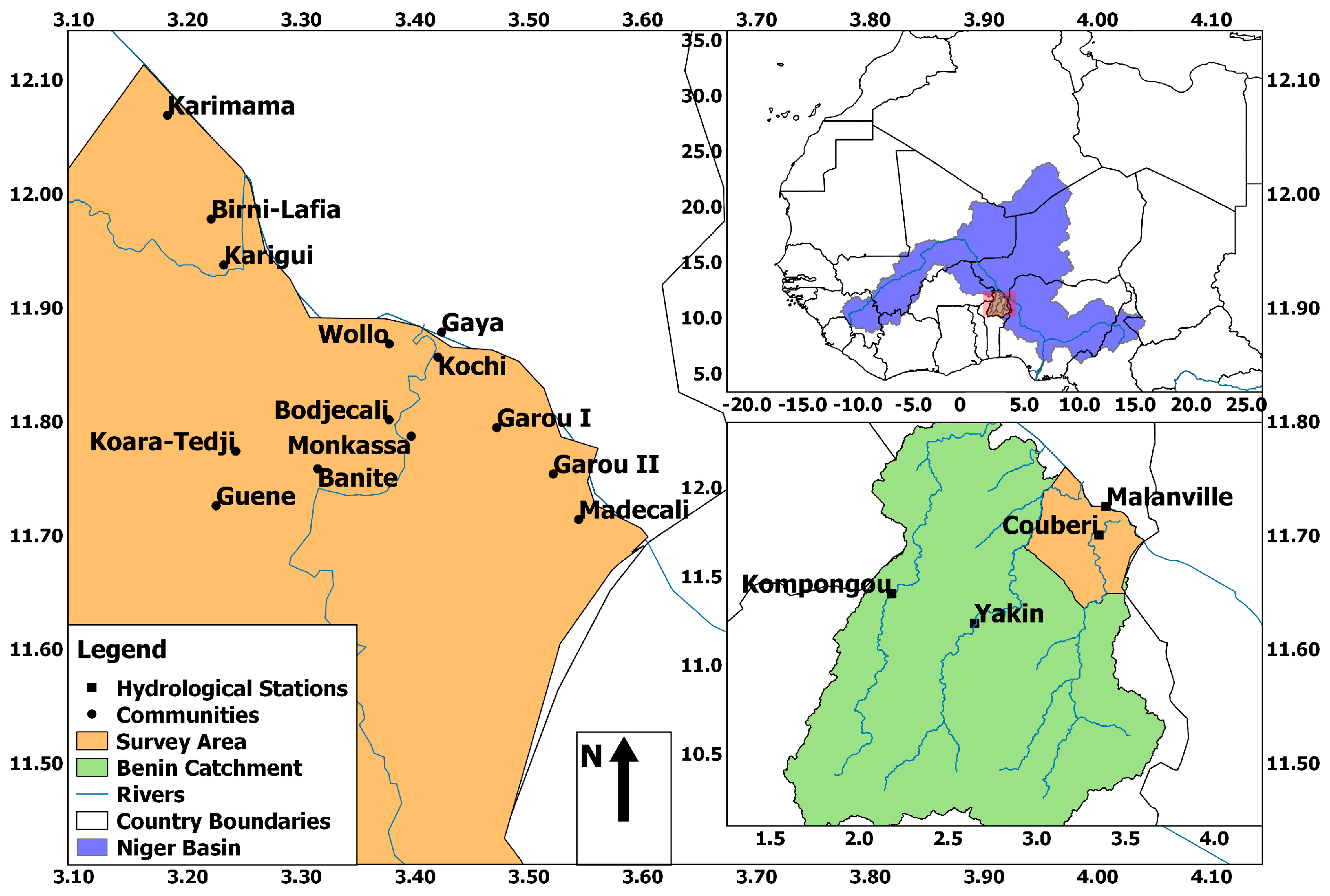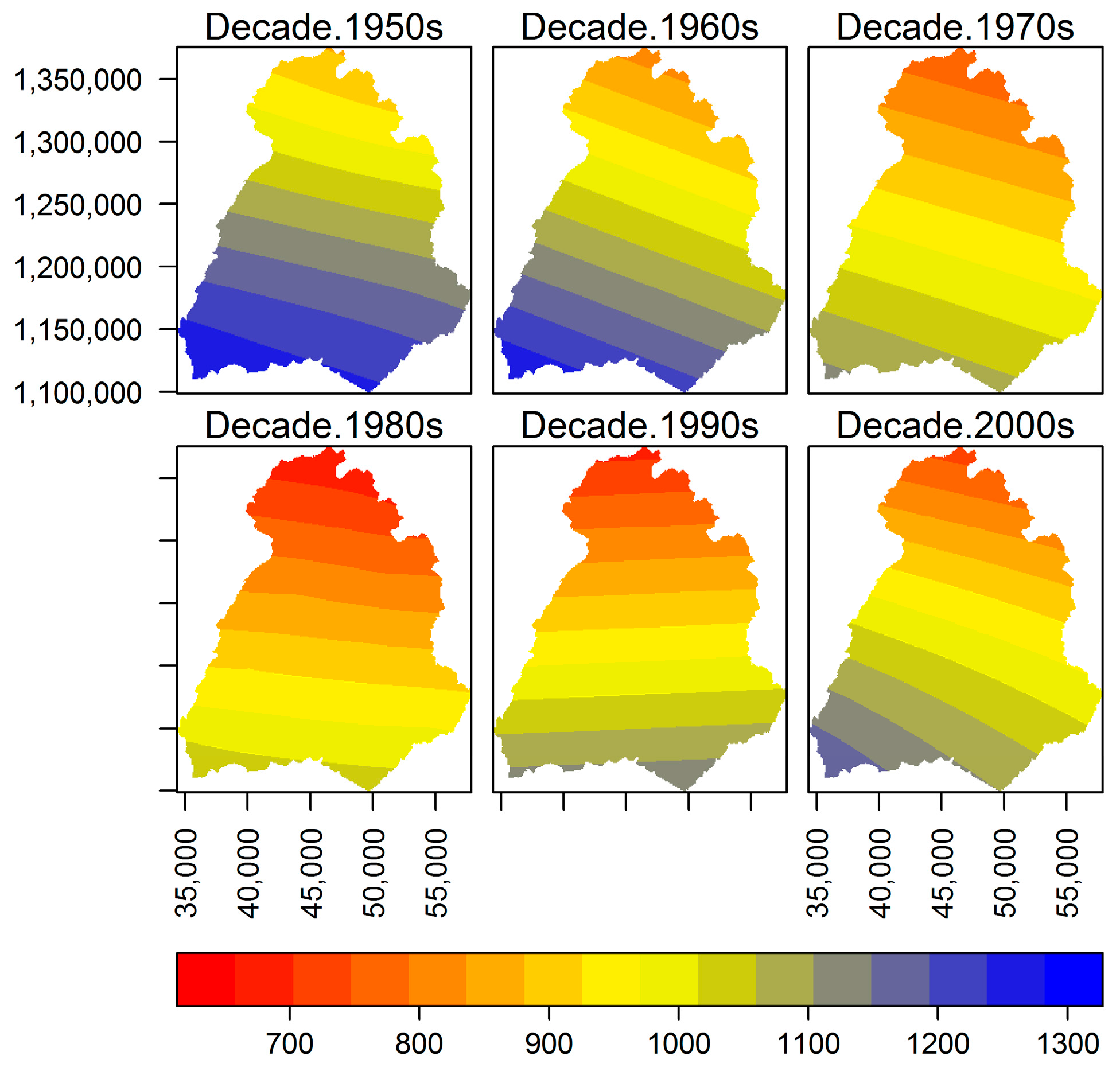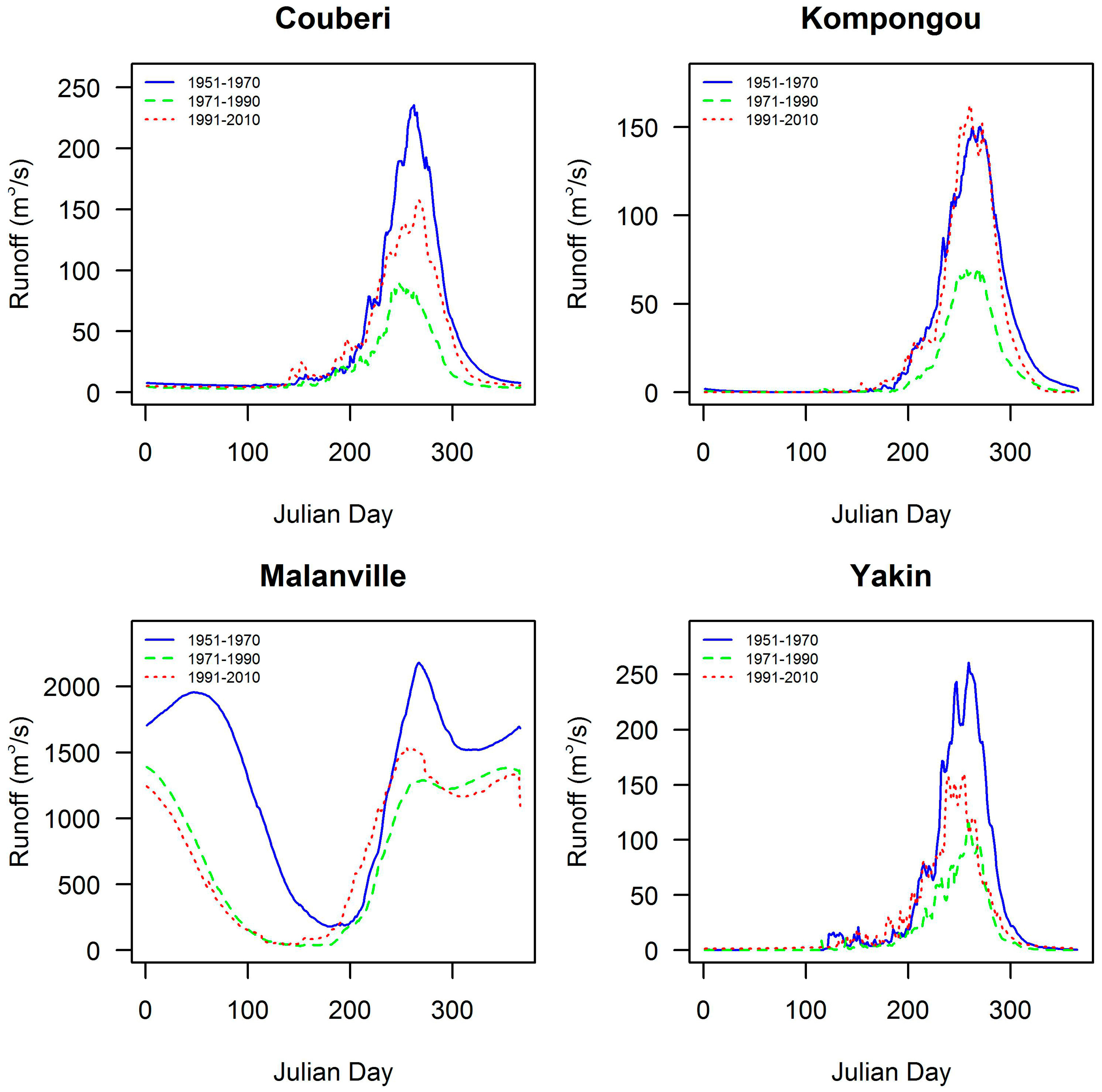Farmers’ Responses to Changing Hydrological Trends in the Niger Basin Parts of Benin
Abstract
:1. Introduction
- Evaluation of hydrological trends in the Niger Basin parts of Benin;
- Assessment of perceptions and local adaptation mechanisms to the hydrological changes.
2. Materials and Methods
2.1. Study Area
2.2. Data Collection
2.3. Data Analysis
2.3.1. Spatial Analysis
2.3.2. Trend Analysis
3. Results
3.1. Hydro-Climatic Trends
3.2. Local Perceptions and Adaptations
4. Discussion
5. Conclusions
Acknowledgments
Author Contributions
Conflicts of Interest
References
- Reyer, C.P.O.; Rigaud, K.K.; Fernandes, E.; Hare, W.; Serdeczny, O.; Schellnhuber, H.J. Turn down the heat: regional climate change impacts on development. Reg. Environ. Chang. 2017, 17, 1563–1568. [Google Scholar] [CrossRef]
- Schewe, J.; Heinke, J.; Gerten, D.; Haddeland, I.; Arnell, N.W.; Clark, D.B.; Dankers, R.; Eisner, S.; Fekete, B.M.; Colón-González, F.J.; et al. Multimodel assessment of water scarcity under climate change. Proc. Natl. Acad. Sci. USA 2014, 111, 3245–3250. [Google Scholar] [CrossRef] [PubMed] [Green Version]
- Sylla, M.B.; Giorgi, F.; Pal, J.S.; Gibba, P.; Kebe, I.; Nikiema, M. Projected Changes in the Annual Cycle of High Intensity Precipitation Events over West Africa for the Late 21st Century. J. Clim. 2015. [Google Scholar] [CrossRef]
- Field, C.B.; Barros, V.R.; Dokken, D.J.; Mach, K.J.; Mastrandrea, M.D.; Bilir, T.E.; Chatterjee, M.; Ebi, K.L.; Estrada, Y.O.; Genova, R.C.; et al. (Eds.) IPCC Summary for policymakers. In Climate Change 2014:Impacts, Adaptation, and Vulnerability, Part A: Global and Sectoral Aspects; Contribution of Working Group II to the Fifth Assessment Report of the Intergovernmental Panel on Climate Change; Cambridge University Press: Cambridge, UK; New York, NY, USA, 2014; pp. 1–32. [Google Scholar]
- Oyebande, L.; Odunuga, S. Climate change impact on water resources at the transboundary level in West Africa: the cases of the Senegal, Niger and Volta basins. Open Hyrol. J. 2010, 4, 163–172. [Google Scholar] [CrossRef]
- Aich, V.; Liersch, S.; Vetter, T.; Huang, S.; Tecklenburg, J.; Hoffmann, P.; Koch, H.; Fournet, S.; Krysanova, V. Comparing impacts of climate change on streamflow in four large African river basins. Hydrol. Earth Syst. Sci. 2014, 4, 1305–1321. [Google Scholar] [CrossRef] [Green Version]
- Aich, V.; Liersch, S.; Vetter, T.; Fournet, S.; Andersson, J.C.M.; Calmanti, S.; van Weert, F.H.A.; Hattermann, F.F.; Paton, E.N. Flood projections within the Niger River Basin under future land use and climate change. Sci. Total Environ. 2016, 562, 666–677. [Google Scholar] [CrossRef] [PubMed]
- Oyerinde, G.T.; Hountondji, F.C.C.; Wisser, D.; Diekkrüger, B.; Lawin, A.E.; Odofin, A.J.; Afouda, A. Hydro-climatic changes in the Niger basin and consistency of local perceptions. Reg. Environ. Chang. 2015, 15, 1627–1637. [Google Scholar] [CrossRef]
- Badou, D.F.; Kapangaziwiri, E.; Diekkrüger, B.; Hounkpè, J.; Afouda, A. Evaluation of recent hydro-climatic changes in four tributaries of the Niger River Basin (West Africa). Hydrol. Sci. J. 2016, 62, 1–14. [Google Scholar] [CrossRef]
- Møller, L.R.; Drews, M.; Larsen, M.A.D. Simulation of Optimal Decision-Making Under the Impacts of Climate Change. Environ. Manag. 2017, 60, 104–117. [Google Scholar] [CrossRef] [PubMed]
- Salick, J.; Byg, A. Indegenous Peoples and Climate Change; University of Oxford and Missouri Botanical Garden May: Oxford, UK, 2007. [Google Scholar]
- N’Tcha M’Po, Y.; Lawin, E.; Yao, B.; Oyerinde, G.; Attogouinon, A.; Afouda, A. Decreasing Past and Mid-Century Rainfall Indices over the Ouémé River Basin, Benin (West Africa). Climate 2017, 5, 74. [Google Scholar] [CrossRef]
- Kotlyakov, V.M.; Komarova, A.I. Elsevier’s Dictionary of Geography; North Holland: Amsterdam, The Netherlands, 2007; ISBN 10: 0-444-51042-7. [Google Scholar]
- KfW Adaptation to Climate Change in the Upper and Middle Niger River Basin. Available online: http://ccsl.iccip.net/niger_river_basin.pdf (accessed on 12 February 2017).
- Legesse, D.; Vallet-Coulomb, C.; Gasse, F. Hydrological response of a catchment to climate and land use changes in Tropical Africa: Case study south central Ethiopia. J. Hydrol. 2003, 275, 67–85. [Google Scholar] [CrossRef]
- Gaikwad, N.; Sawant, R. Analyzing Kriging method and creating an application using Kriging. In Proceedings of the 2016 IEEE International Conference on Cloud Computing and Big Data Analysis ICCCBDA, Chengdu, China, 5–7 July 2016; pp. 171–176. [Google Scholar]
- Kumar, V. Optimal contour mapping of groundwater levels using universal kriging—A case study. Hydrol. Sci. J. 2007, 52, 1038–1050. [Google Scholar] [CrossRef]
- R Development Core Team R: A Language and Environment for Statistical Computing. Available online: http://www.r-project.org (accessed on 13 August 2015).
- Verstraeten, G.; Poesen, J.; Demarée, G.; Salles, C. Long-term (105 years) variability in rain erosivity as derived from 10-min rainfall depth data for Ukkel (Brussels, Belgium): Implications for assessing soil erosion rates. J. Geophys. Res. Atmos. 2006, 111, 1–11. [Google Scholar] [CrossRef]
- Královec, V. Trend analysis of rainfall-runoff regimes in selected headwater areas of the Czech Republic. J. Hydrol. Hydromech. 2011, 36–50. [Google Scholar] [CrossRef]
- Pettitt, A.N. A Non-Parametric Approach to the Change-Point Problem. Appl. Stat. 1979, 28, 126. [Google Scholar] [CrossRef]
- Lucio, P.; Molion, L.; Valadão, C.; Conde, F.; Ramos, A.; MLD, M. Dynamical outlines of the rainfall variability and the ITCZ role over the West Sahel. Atmos. Clim. Sci. 2012, 2, 337–350. [Google Scholar] [CrossRef]
- Inger, A.; Ousmane, D.; Martha, J.-H.; Jean-Claude, O. The Niger River Basin: A Vision for Sustainable Management; Golitzen, K.G., Ed.; The World Bank: Washington, DC, USA, 2005; ISBN 9780821362037. [Google Scholar]
- Amogu, O.; Descroix, L.; Yéro, K.S.; Le Breton, E.; Mamadou, I.; Ali, A.; Vischel, T.; Bader, J.-C.; Moussa, I.B.; Gautier, E.; et al. Increasing River Flows in the Sahel? Water 2010, 2, 170–199. [Google Scholar] [CrossRef]
- Descroix, L.; Mahé, G.; Lebel, T.; Favreau, G.; Galle, S.; Gautier, E.; Olivry, J.-C.; Albergel, J.; Amogu, O.; Cappelaere, B. Spatio-temporal variability of hydrological regimes around the boundaries between Sahelian and Sudanian areas of West Africa: A synthesis. J. Hydrol. 2009, 375, 90–102. [Google Scholar] [CrossRef]



| S/N | Station Names | Latitude (UTM) | Longitude (UTM) |
|---|---|---|---|
| 1 | Karimama | 519,953 | 1,333,932 |
| 2 | Malanville | 543,565 | 1,311,841 |
| 3 | Alfakoara | 507,272 | 1,265,738 |
| 4 | Banikoara | 438,158 | 1,249,211 |
| 5 | Kandi | 492,720 | 1,230,723 |
| 6 | Kerou | 401,622 | 1,197,696 |
| 7 | Tanguieta | 310,377 | 1,174,123 |
| 8 | Kouande | 355,837 | 1,142,565 |
| 9 | Natitingou | 322,972 | 1,140,872 |
| 10 | Birni | 337,408 | 1,103,935 |
| 11 | Ina | 470,771 | 1,101,739 |
| 12 | Nikki | 521,924 | 1,098,048 |
| 13 | Kalale | 541,973 | 1,138,607 |
| 14 | Bembereke | 463,491 | 1,127,544 |
| 15 | Djougou | 353,728 | 1,072,531 |
| 16 | Partago | 379,270 | 1,054,009 |
| 17 | Okpara | 470,728 | 1,046,457 |
| 18 | Parakou | 456,077 | 1,033,573 |
| 19 | Segbana | 576,490 | 1,208,697 |
| 20 | Niamey | 409,843 | 1,490,703 |
| 21 | Oaugadougou | 336,908 | 1,365,713 |
| 22 | Sokoto | 730,351 | 1,388,299 |
| 23 | Yelwa | 658,665 | 1,164,379 |
| Station/Statistics | Mann-Kendall | Pettit | |||||
|---|---|---|---|---|---|---|---|
| S | Z | p | Trend | K | p | n | |
| Rainfall | |||||||
| Karimama | −432.00 | −2.68 | 0.01 | Decreasing | 1981 | 0.01 | 61 |
| Malanville | −431.00 | −2.68 | 0.01 | Decreasing | 1971 | 0.01 | 61 |
| Alfakoara | −148.00 | −0.91 | 0.36 | No Trend | 1977 | 0.32 | 61 |
| Banikoara | −374.00 | −2.32 | 0.02 | Decreasing | 1973 | 0.02 | 61 |
| Kandi | −319.00 | −1.98 | 0.05 | Decreasing | 1980 | 0.05 | 61 |
| Kerou | −251.00 | −1.56 | 0.12 | No Trend | 1970 | 0.04 | 61 |
| Tanguieta | −121.00 | −0.75 | 0.46 | No Trend | 1976 | 0.13 | 61 |
| Kouande | −450.00 | −2.79 | 0.01 | Decreasing | 1971 | 0.01 | 61 |
| Natitingou | −448.00 | −2.78 | 0.01 | Decreasing | 1970 | 0.01 | 61 |
| Birni | −156.00 | −0.96 | 0.33 | No Trend | 1970 | 0.03 | 61 |
| Ina | −388.00 | −2.41 | 0.02 | Decreasing | 1970 | 0.01 | 61 |
| Nikki | −102.00 | −0.63 | 0.53 | No Trend | 1969 | 0.22 | 61 |
| Kalale | −429.00 | −2.66 | 0.01 | Decreasing | 1970 | 0.03 | 61 |
| Bembereke | −378.00 | −2.35 | 0.02 | Decreasing | 1971 | 0.01 | 61 |
| Djougou | −14.00 | −0.08 | 0.94 | No Trend | 1973 | 0.59 | 61 |
| Partago | −88.00 | −0.54 | 0.59 | No Trend | 1980 | 0.27 | 61 |
| Okpara | −152.00 | −0.94 | 0.35 | No Trend | 1969 | 0.15 | 61 |
| Parakou | −44.00 | −0.27 | 0.79 | No Trend | 1969 | 1.04 | 61 |
| Segbana | −430.00 | −2.67 | 0.01 | Decreasing | 1972 | 0.01 | 61 |
| Niamey | −169.00 | −1.36 | 0.17 | No Trend | 1968 | 0.09 | 51 |
| Ouagadougou | −584.00 | −3.63 | 0.01 | Decreasing | 1977 | 0.01 | 61 |
| Sokoto | 60.00 | 0.51 | 0.61 | No Trend | 1990 | 0.20 | 49 |
| Yelwa | 82.00 | 1.06 | 0.29 | No Trend | 1991 | 0.18 | 37 |
| River Discharge | |||||||
| Couberi | −233.00 | −1.88 | 0.06 | No Trend | 1972 | 0.01 | 51 |
| Kompongou | −102.00 | −1.64 | 0.10 | No Trend | 1972 | 0.12 | 32 |
| Malanville | −605.00 | −4.91 | 0.01 | Decreasing | 1971 | 0.01 | 51 |
| Yakin | −278.00 | −3.11 | 0.01 | Decreasing | 1970 | 0.01 | 41 |
| Socioeconomics of Respondents | |||
|---|---|---|---|
| Economic Activities | Crop Production | 61.0 | |
| Animal Husbandry | 21.0 | ||
| Fisheries | 11.0 | ||
| Others | 7.0 | ||
| Hydrological Variability | |||
| Crop | Animal | Fish | |
| Rainfall | |||
| Higher | 98.0 | 97.5 | 95.0 |
| Lower | 1.0 | 2.5 | 5.0 |
| Unchanged | 1.0 | 0.0 | 0.0 |
| Runoff | |||
| Higher | 92.0 | 100.0 | 85.0 |
| Lower | 1.8 | 0.0 | 5.0 |
| Unchanged | 6.1 | 0.0 | 10.0 |
| Flood | |||
| Higher | 89.0 | 80.0 | 85.0 |
| Lower | 3.0 | 0.0 | 10.0 |
| Unchanged | 8.0 | 20.0 | 5.0 |
| Variables | Crop | Animal | Fish |
|---|---|---|---|
| Soil and Water Conservation Mechanisms | |||
| Water storage | 17.0 | 20.0 | 5.0 |
| Flood control | 39.0 | 62.0 | 65.0 |
| Water treatment | 84.0 | 92.0 | 80.0 |
| Agroforestry | 63.0 | 30.0 | 40.0 |
| Soil amendment | 52.0 | 13.0 | 20.0 |
| Reclamation | 57.0 | 27.0 | 40.0 |
| Mulching | 18.0 | 28.0 | 45.0 |
| Irrigation | 92.0 | 92.0 | 90.0 |
| Drought | |||
| Alternative water/irrigation | 95.0 | 100.0 | 100.0 |
| Diversification | 95.0 | 100.0 | 100.0 |
| Genetic improvement | 92.0 | 88.0 | 85.0 |
| Abandon | 48.0 | 50.0 | 71.0 |
| Migration | 65.0 | 63.0 | 71.0 |
| Water pond | 81.0 | 38.0 | 57.0 |
| Reduction | 71.0 | 50.0 | 57.0 |
| Management | 64.0 | 50.0 | 42.0 |
| Flood | |||
| Drainage | 54.0 | 75.0 | 85.0 |
| Dam/dike | 41.0 | 75.0 | 71.0 |
| Abandon | 55.0 | 75.0 | 71.0 |
| Diversification | 82.0 | 100.0 | 85.0 |
| Protection | 44.0 | 75.0 | 71.0 |
© 2017 by the authors. Licensee MDPI, Basel, Switzerland. This article is an open access article distributed under the terms and conditions of the Creative Commons Attribution (CC BY) license (http://creativecommons.org/licenses/by/4.0/).
Share and Cite
Oyerinde, G.T.; Lawin, E.A.; Odofin, A.J. Farmers’ Responses to Changing Hydrological Trends in the Niger Basin Parts of Benin. Hydrology 2017, 4, 52. https://doi.org/10.3390/hydrology4040052
Oyerinde GT, Lawin EA, Odofin AJ. Farmers’ Responses to Changing Hydrological Trends in the Niger Basin Parts of Benin. Hydrology. 2017; 4(4):52. https://doi.org/10.3390/hydrology4040052
Chicago/Turabian StyleOyerinde, Ganiyu Titilope, Emmanuel Agnidé Lawin, and Ayo J. Odofin. 2017. "Farmers’ Responses to Changing Hydrological Trends in the Niger Basin Parts of Benin" Hydrology 4, no. 4: 52. https://doi.org/10.3390/hydrology4040052
APA StyleOyerinde, G. T., Lawin, E. A., & Odofin, A. J. (2017). Farmers’ Responses to Changing Hydrological Trends in the Niger Basin Parts of Benin. Hydrology, 4(4), 52. https://doi.org/10.3390/hydrology4040052





